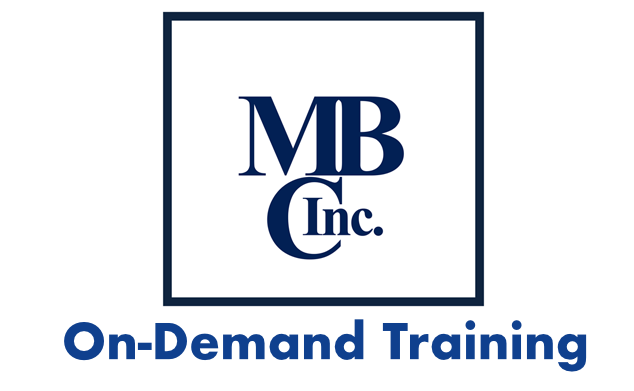September 24, 2012
MBC, Inc. – Tips –Volume 2 – Tip 6
Bi-Monthly Informational Guide
MBC, Inc. Quality Tips
Internal Audit
ISO/TS 16949, ISO 9001
This edition addresses the ISO 9001 and ISO/TS 16949 Standards, clauses 6.2.2.2 and 6.2.2.3, both of these clauses address training and the effectiveness of training for all personnel doing work that affects product and/or service quality.
Clause 6.2.2.2 “The organization shall establish and maintain documented procedures for identifying training needs and achieving competence of all personnel performing activities affecting conformity to product requirements.”
Clause 6.2.2.3 “The organization shall provide on-the-job training for personnel in any new or modified job affecting conformity to product requirements, including contract or agency personnel.”
Clause 5.6.1 “Top management shall review the organization’s quality management system, at planned intervals, to ensure its continuing suitability, adequacy and effectiveness.”
Taken together, and in context, these three excerpts define some of the requirements of operator training, competence of personnel and the effectiveness of the overall training system. How many manufacturing organizations have operations personnel that do not follow job or work instructions, alter job or work instructions, do work out-of-sequence or omit required inspections or verifications? This non-compliant behavior is often the result of inadequate training in the proper work methods or lack of enforcement of requirements to the job or work instructions.
This is a situation where the organization’s Internal Auditors can have a very positive effect on the operation and slowly bring around some much needed improvement and increase in customer satisfaction as well as cost savings.
Consider the follow scenario and the development of the “Audit-Trail”.
In the Quality Department, the auditor was examining the Customer Complaint File, and found multiple issues over the past several months that indicated the customer had received product with “Bowed-Side-Panels”. Documentation for each case identified the unit serial number, date and time of build as well as pictures of the condition. The resulting Corrective Action indicated a Root-Cause of “Operator Error”; the Corrective Action was “Retrain all Operators”. Documentation indicated this nonconformance as six independent cases over the past nine weeks; each of the six had the same Root-Cause and the same Corrective Action. Each case had from two to eleven units (with serial numbers) of each occurrence. When the auditor ask for the traceability data for the serial numbers in question it was found that product was produced on all three shifts for the six cases documented in the Customer Complaint File.
Auditing the operations department (Assembly) the auditor was verifying the compliance of two of the assemblers on line one. The auditor had reviewed the assembly/job instructions and had become familiar with the job requirements of each operation. While on the line with the Guide the auditor observed both operators at operation 10/A-B were not following the approved job instructions for torque sequence of four fasteners that secured the Right and Left Side panel of the assembly. The Job instruction required a specific torque sequence “Top fastener first, Bottom fastener second and the two middle fasteners in any order. The auditor observed the operators completing the torque sequence from top to bottom without regard to the Job Instruction requirement. The result was a bowed side panel due to induced stress from the incorrect torque sequence. The auditor verified the build process on all three shifts and found similar occurrences of noncompliance to work instructions concerning incorrect torque sequence. The Guide, the Operators affected and the line Supervisors on each shift verified the noncompliance.
The auditor recorded the names of the operators involved in the audit and verified training records at the appropriate Supervisors desk and in Human Resources. The records indicate all the operators had received the initial required training for the affected operations, additionally each operator had been “retrained” after each customer complaint. It is obvious from the objective evidence that this approach has not worked in the past and there is no reason to expect it will work in the future.
The previous scenario with some modification is typical of many manufacturing organizations. Over my last twenty-five years of auditing and consulting, I have seen this scenario played out repeatedly. The question is “How does the organization fix this problem once and for all”?
Based on the objective evidence available it is obvious that a Corrective Action Request is required. The question becomes what you write up and to whom the Corrective Action is assigned. The department complies with the training procedure as all operators have received the training and the training records are in order.
The organization complies with the clauses identified at the beginning of this article 6.2.2.2 and 6.2.2.3; this is NOT a training issue as it appears. This is an effectiveness issue as defined in clause 5.6.1;
(5.6.1 “Top management shall review the organization’s quality management system, at planned intervals, to ensure its continuing suitability, adequacy and effectiveness.”)
What the objective evidence shows is the lack of implementation of the requirements. Operators are properly trained but Supervisors are not enforcing the requirements and Middle and Top Managers are not following up from the Management Review process that has identified this problem to ensure proper “work practice”. There is also evidence of “in-effective corrective action”; this is a repeat problem with the same Root Cause and same Corrective Action. It would be appropriate to write two CARs. One to address the lack of implementation of work requirements, i.e. following job instructions correctly, and one to address in-effective corrective action; however, I would only write one CAR. If you address the implementation issue, the “in-effective corrective action” becomes a moot point, as it is a part of the CAR closure.
The CAR could be written as;
“Objective evidence indicates lack of effective enforcement of Operator Training on Operation 10/A-B. The customer complaint file shows multiple incidents of “Bowed Side Panels due to improper torque sequence”. All operators have been properly trained but were observed by the Auditor, Guide, and the line Supervisor using an incorrect torque sequence as defined by work instruction, WI-10/A-B-6/1/2012. There is no objective evidence of effective implementation of the work requirements for the torque sequence requirements of this operation.”
ü “I can be committed to quality and not be involved in quality”
ü “I CAN NOT be involved in quality and not be committed to quality”
“The involvement of a Committed Management Team is an Unbeatable Combination”
Spread the News
Please forward these editions to others in your organization so they may receive the benefited of this newsletter. Tell other members of your company to go to www.MBCINcorp.com and sign-up for this newsletter by downloading the free report in the upper right corner of the home page.
For additional information about the Internal Audit Process, you may contact the President of MBC, Inc. at anytime; Phone 931.637.1446, or E-mail – Bmartin@MBCIncorp.com
Thank You
Bill Martin – President
MBC, Inc.

